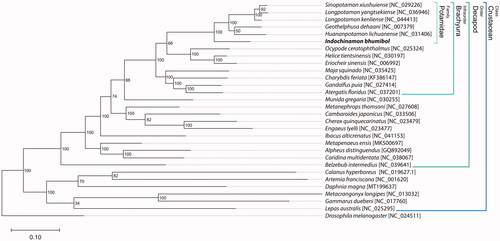Abstract
Indochinamon bhumibol has been found as the biggest freshwater crab in Thailand. In this study, we report the first complete sequence of mitochondrial genome from I. bhumibol encoding 13 protein-coding genes, 22 transfer RNAs, and 2 ribosomal RNAs. The nucleotide composition of I. bhumibol mitogenome showed a strong AT bias (70.4%) with a low GC content (29.6%). Comparative phylogenetic analysis with 28 crustaceans based on nine conserved genes demonstrated that I. bhumibol was closely related to members of the Potamidae family.
Indochinamon spp. is a giant mountain crab, which is broadly found in Myanmar, Vietnam, and northern Thailand epically in waterfall and mountain areas (Van et al. Citation2016; Ng & Mar Citation2018). Indochinamon bhumibol was reported as the biggest freshwater crab in Thailand that has a significant role as a non-polluted water indicator in the freshwater ecosystem and has been considered as one of the endangered species (Thaewnon-Ngiw and Suthamrit Citation2020). Taxonomical identification of I. bhumibol can be difficult due to large morphological variations; therefore, the genetic information of Indochinamon spp. is necessary for this aspect. Here, we assembled the first complete mitochondria genome of I. bhumibol and created the phylogenetic tree for taxonomy classification.
The specimens of I. bhumibol were collected from Phu Nang National Park, Phayao Province, Thailand (19°08′47.76″N, 100°12′03.46″E). The collected specimen was transported and stored at the Museum of Agricultural University of Phayao with voucher number AUP02360. Genomic DNA was extracted from pereopods muscle by QIAamp Tissue Kit (Qiagen, Germany) and sequenced by Illumina MiSeq sequencer (2 × 150 bp ends) (Illumina, USA). After getting the cleaned read, the mitochondrial genome was assembled using NOVOPlasty 3.8.2 (Dierckxsens et al. Citation2016) and annotated by the MITOS web server (Bernt et al. Citation2013). Protein-coding genes (PCGs), ribosomal RNA genes (rRNAs), and transfer RNA genes (tRNAs) were confirmed using the NCBI Basic Local Alignment Search Tool (BLAST) (Altschul et al. Citation1990).
The I. bhumibol mitogenome was 16,351 bp consisting of 13 PCGs, 22 tRNAs, and 2 rRNAs. The mitogenome sequence was submitted to GenBank under accession number MT872370. Among them, 11 PCGs were initiated by ATN as a start codon with an exception of ND1 and ATP8, starting with GTC and GTG, respectively. The incomplete stop codons (T––) were found in three (COI, ND5, and CYTB) genes while the remaining showed the canonical stop codons (TAA or TAG). Twenty-two tRNAs were ranged from 61 bp (tRNAThr) to 71 bp (tRNAVal). The asymmetric composition of nucleotide sequence was found with a high AT ratio (A: 34.8%, T: 35.6%, G: 10.9%, C: 18.7%).
A phylogenetic tree of I. bhumibol with other 28 crustaceans species was carried out using Drosophila melanogaster as an outgroup (). Nine conserved genes (COI, COII, COIII, ND1, ND3, ND4, ND4L, ND5, ND6, and CYTB) were selected to perform multiple alignments by MUSCLE 3.8.1 (Edgar Citation2004). Using MEGA X 10.1 (Kumar et al. Citation2018) with 1000 bootstrap replications, the maximum likelihood phylogenetic tree was generated. The result indicated that I. bhumibol is closely related to other freshwater crab species of family Potamidae forming a separate clade. In conclusion, the mitogenome sequence of I. Bhumibol reveals a piece of valuable genetic information to fill the gap in phylogenetic knowledge of the Potamidae family.
Acknowledgements
We acknowledge the Unit of Excellence 2020 on Biodiversity and Natural Resources Management, University of Phayao for contributing to sample collection.
Disclosure statement
No potential conflict of interest was reported by the author(s).
Data availability statement
The data that support the findings of this study are openly available in GenBank of NCBI at https://www.ncbi.nlm.nih.gov/, accession number: MT872370.
Additional information
Funding
References
- Altschul S, Gish W, Miller W, Myers E, Lipman D. 1990. Basic local alignment search tool. J Mol Biol. 215(3):403–410.
- Bernt M, Donath A, Jühling F, Externbrink F, Florentz C, Fritzsch G, Pütz J, Middendorf M, Stadler PF. 2013. MITOS: improved de novo metazoan mitochondrial genome annotation. Mol Phylogenet Evol. 69(2):313–319.
- Dierckxsens N, Mardulyn P, Smits G. 2016. NOVOPlasty: de novo assembly of organelle genomes from whole genome data. Nucleic Acids Res.
- Edgar R. 2004. MUSCLE: multiple sequence alignment with high accuracy and high throughput. Nucleic Acids Res. 32(5):1792–1797.
- Kumar S, Stecher G, Li M, Knyaz C, Tamura K. 2018. MEGA X: molecular evolutionary genetics analysis across computing platforms. Mol Biol Evol. 35(6):1547–1549.
- Ng P, Mar W. 2018. On a new species of freshwater crab, Indochinamon khinpyae, from northern Myanmar (Crustacea, Brachyura, Potamidae). Zookeys. 811:47–63.
- Thaewnon-Ngiw B, Suthamrit W. 2020. Morphometry of mountain crabs (Crustacea: Decapoda: Brachyura: Potamidae) from Phetchabun Mountains Thailand. Interdiscip Res Rev. 15(2):24–31.
- Van TD, Nguyen TC, Hung AL. 2016. A new species of the genus Indochinamon Yeo & Ng, 2007 (Crustacea: Brachyura: Potamoidea: Potamidae) from northern Vietnam. Raffles Bull Zool. 2016(64):187–193.

